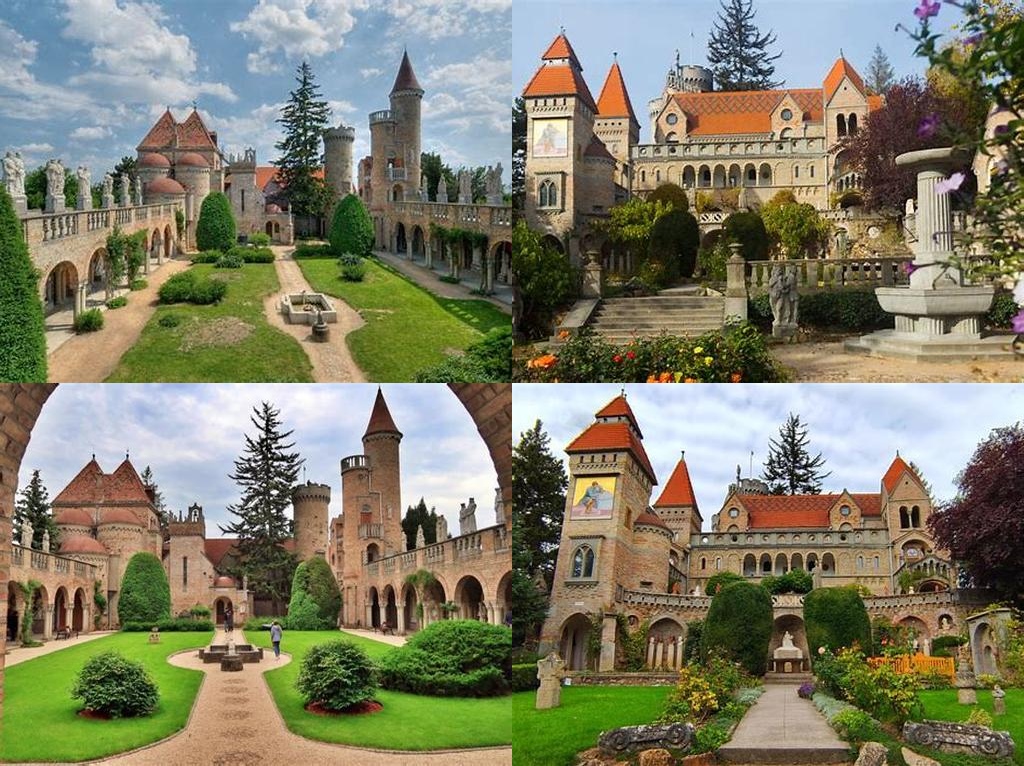
Bory-vár, nestled in the vibrant city of Székesfehérvár, is unlike any other castle you’ll encounter in Hungary—or, really, anywhere. It rests quietly off the usual tourist path, its whimsical silhouette rising from leafy neighborhoods rather than brooding atop some dramatic crag. Yet as you approach, you’ll soon sense that this isn’t a relic of medieval strife or royal ambitions but something far more personal: the uncontainable dream of one man. That man was Jenő Bory, an architect, sculptor, and university professor whose life’s work became equal parts castle, gallery, and love letter.
Bory started work on his magnum opus in 1923, and continued, brick by brick, for 41 years—until his death in 1959. This isn’t a castle forged by armies or shaped by political tides. Instead, imagine decades of patient vision, hands-on labor, and sheer creative stubbornness. What you see today—a hotchpotch of turrets, twisting staircases, and sunny courtyards—is both intimate and fantastical. Parts of the structure mimic Gothic, Romanesque, and Baroque forms, borrowing the playful drama of storybook fortresses rather than imitating anything from history books. It’s earnest, slightly eccentric, and somehow makes you feel that even the wildest of ideas can take solid, lasting shape if someone believes in them enough.
The castle’s origins add a beautifully human dimension to its labyrinthine corridors and mosaic-studded towers. Bory devoted the edifice to his wife, Ilona Komocsin, the muse who appears in countless paintings and statues dotted around the castle. Legend has it that Bory laid down each stone himself, often after days spent teaching at Budapest’s Technical University, using up his evenings and weekends for construction and sculpting. There’s no grand hall of mirrors here, no tales of political intrigue—just layers of personal history, every alcove whispering stories of love, persistence, and creative freedom. It’s charmingly clear as you wander: this castle was built for art and affection rather than for throne or defense.
Stepping inside, you’ll quickly notice the castle’s unique energy. Each section carries its own spirit, from grand, columnar loggias to intimate rooftops offering views over Székesfehérvár’s gardens and distant church spires. The Gallery and Chapel burst with Bory’s statues, reliefs, and colorful stained glass—works that teeter between spiritual grandeur and playful, sometimes whimsical experiment. It’s not just the master’s hand you’ll see, either; you’ll spot works by Ilona, also an accomplished artist, hanging alongside.
One of the most memorable spaces is the so-called “Hall of Wives,” a sunlit room in which Bory honored not only Ilona but a pantheon of famous women who inspired hunks of Hungarian poetry and folk song. The stained glass windows glow with brilliant figures—some real, some imagined—while busts and painted murals orbit the heart of the room. Descending to the courtyard, keep an eye out for the Seven Chieftains of the Magyars, whose weathered forms watch over visitors with stony pride.
Wandering the grounds feels a bit like wandering through Bory’s mind (or even his dreams). There are nooks for reading, alcoves for quiet reflection, and surprise staircases descending into shade or climbing to panoramic views. Easy to miss, but well worth seeking, is the collection of old tools and wooden ladders—poignant reminders that all this was once just bricks, sweat, and determination. Children tend to race up the spiral stairways, marvelling at discoveries in every turret, while adults often pause to absorb the sense of craftsmanship and care behind every cornice and curve.
Unlike the monumental castles at Buda or Eger, Bory-vár is entirely without pretense. Entry feels personal, even welcoming; nothing is roped off with velvet or guarded with dour authority. Exhibits are approachable, with family photographs and vintage letters helping you piece together the Borys’ story. This is a living place—part folk-art fantasy, part family home, and all the more special for it. Even if you’re not a history buff or architecture aficionado, you’ll find yourself drawn in by the sheer individuality and heart that pulse through every stone.
Easy to reach by foot or local bus from central Székesfehérvár, the castle is a much-loved spot for locals—a favorite for hazy summer afternoons or wintry walks through frosted gardens. If you’re lucky, you might catch an art exhibit or community concert during your visit—a subtle sign that Bory’s dream is still evolving, still a living part of the city’s cultural fabric. In a country filled with grand historic sites, Bory-vár quietly (but unforgettably) makes the case for passion, persistence, and the beauty of dreams turned to stone.





